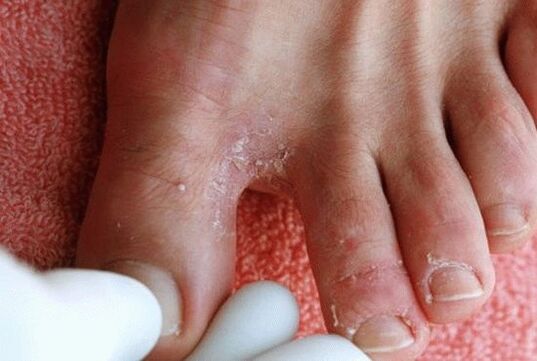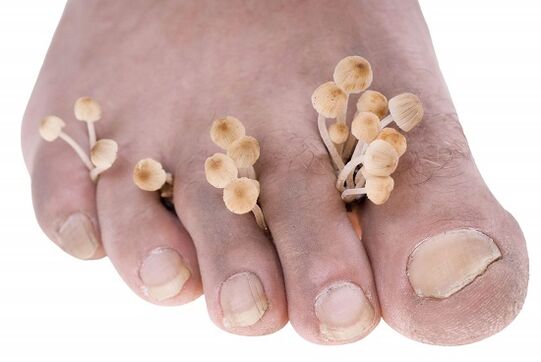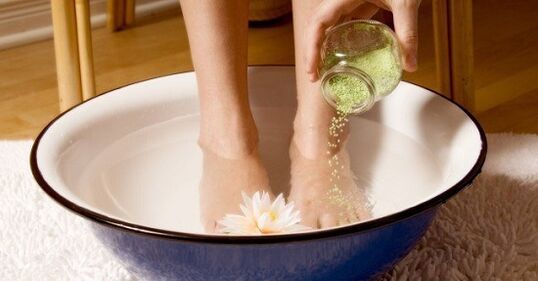In the minds of many, fungal patients are often associated with clutter, misery, and contamination. This stereotype is not entirely true. In the modern world, even the most pedantic cleanliness is free of fungal infections. In addition, a person with an active and healthy lifestyle is more likely to catch it than a classic sofa. If the skin between the toes is reddened, peeled and cracked, the nails turn yellow and crumbled, and the unbearable itching doesn’t leave you for a minute, chances are you have fungus.
Routes of infection
According to medical statistics, every 4-5 of our planets. His man is sick with mycosis of the toes. The risk of infection is everywhere: in the pool, sauna, gym, public shower, shoe store, beach, and even your own shoes are often an excellent environment for life and active mushroom growth.

Walking barefoot, wearing someone else’s or wet shoes, sharing personal hygiene items (towels, manicure and pedicure tools), dirty socks, excessive sweating, degenerative foot disease, overweight, circulatory problems - these and other factors are directly or indirectly infected with a fungal infection.
Healthy nails are virtually invulnerable to fungi, while nail plates that have been altered by some traumatic factor are easy prey for it. The same thing happens with the skin - the microscopic cracks on it become the entrance gate to the infection.
The infection is most often caused by fungal parasites called dermatophytes, and less often by yeasts and molds. The fungus on the toes of both men and women is diseased. The risk of infection increases with age. Thus, children relatively rarely fall victim to this parasite, while after 70 years, every second adult is the active carrier.
The first manifestations of the fungus

In most cases, the lesions of the legs associated with a fungal infection occur gradually, according to the following pattern:
- the first signs are observed in the form of peeling, burning and itching of the skin between the toes;
- the skin responds to the infection by forming bubbles, cracking after a while;
- cracks and grooves appear at the site of the bubbles; the itching increases;
- when applied to the nails, the fungus actively multiplies, gradually penetrates the nail plate, slowly and for a long time destroys it;
- the plate thickens, peels, crumbles, acquires unnatural yellowness.
Dermatophytic fungi appear as bright yellow spots or streaks closer to the edge of the nail. Over time, the infection moves to the central part, the skin in the interdigital region ruptures, and severe itching is felt. The yeasts feed on the nail plate, thinning the side. As a result, waves, grooves, cracks appear, the nail turns yellow and separates from its bed. First, the yeast attacks the nail folds. They turn red, thicken and swell, with silver scales appearing on the edges. It is possible to attach a secondary bacterial infection with subsequent support. Molds superficially affect the nails, changing their shadows from yellow and green to brown and even black. These fungi are especially active in the case of poor nutrition of nail plates.
Why not hesitate to see a doctor?
Treatment should be started as soon as possible. It is good if this happens before the infection, which is usually first localized between the toes, spreads to the nail plate. Early medical care provides faster healing and healthier nails.

The mycologist deals with the treatment of various fungal skin changes (mycoses). Doctors with such a profile are difficult to find in public clinics. If this is not the case, you can consult a dermatologist. The task of the specialist is to assess the extent and depth of the lesion, to perform tissue scraping to determine the presence and type of the fungus, and to develop a competent therapeutic regimen.
Before starting treatment, disinfection measures should be taken, including treating all shoes with vinegar or formalin. The unpleasant smell of these products makes its use unpleasant. To solve this problem, you can buy a special device at the pharmacy that uses ultraviolet rays to disinfect your shoes.
Traditional treatment for foot fungus
The fungus can be treated with topical, systemic or combination therapy.

Any treatment involves the use of antifungal agents (antifungals):
- Topical treatment (ointments, creams, sprays). Antifungals for external use and other medicines with the active substances clotrimazole, naftifine hydrochloride, ketoconazole, terbinafine hydrochloride or bifonazole. For minor damage to the nail plate, the use of antifungal varnishes is recommended. Varnishes are applied throughout the year, gradually reducing the frequency of use (from 4 to 1 per week). Topical remedies are effective in relieving itching and burning, reducing flaking, cracking of the skin between the toes, but are unable to completely cure the disease.
- Systemic therapy: general antifungal agents. Such a treatment is appropriate in the event of complete damage to the nail plate. But there are certain contraindications to systemic antifungals: they should not be taken by pregnant and lactating women, those with kidney or liver disease, and young children.
- Comprehensive treatment. Includes local and systemic therapy.
Patients often complain about the ineffectiveness of traditional therapy and resort to treatment with folk remedies. Against the background of such complaints, the opinion was formed that the symptomatic manifestations of the foot fungus, its symptoms (itching, peeling, cracks) can only be removed temporarily. Why is patient dissatisfaction observed? Everything is very simple. In fact, complete cure of the fungus is difficult but possible. The most important thing is to adhere to the principles of regularity and duration. It is very important that you do all your therapeutic activities every day and do not interrupt what you have started halfway. You should be ready for long-term treatment (usually 3-12 months), which should be done until new healthy nails grow back. In advanced cases, the affected nail plates should be removed and only then wait for new ones to appear.
Treatment of foot fungus with folk remedies
Recipes from traditional medicine are very effective in eliminating or reducing fungal manifestations such as itching, burning, cracking, peeling and redness between the toes. Some patients claim that they could completely cure the disease using only folk remedies.

So to treat the fungus:
- Soak your feet in apple cider vinegar, wine vinegar or table vinegar.
- apply 1 drop of iodine to each nail twice a day;
- wipe skin and nails with salicylic acid ointment;
- wash your feet with soap;
- make a garlic and buttered compress;
- lubricate the affected skin with a mixture of garlic juice, alcohol (1 tablespoon each) and water (2 tablespoons);
- treat the affected areas with propolis alcohol tincture.
Garlic and propolis are thought to be particularly effective in fighting fungi. It is important to understand that the duration of treatment with folk remedies is limited. If your skin cracks within 3 months and you don’t get the same look, you may want to seek help from traditional medicine.
Despite the fact that treatment with folk remedies is effective and the success of modern pharmacy in inventing new effective drugs, mycosis of the legs is still the most common fungal disease. Nevertheless, it is gratifying that the number of patients who have successfully recovered has decreased every year for the past 20-30 years.

























